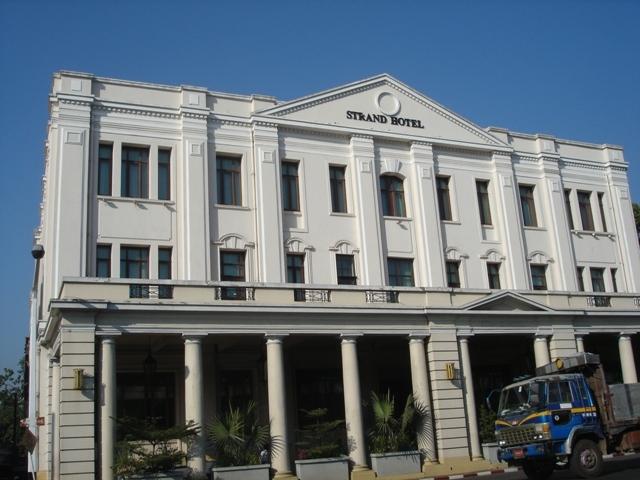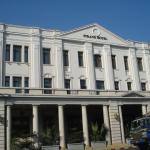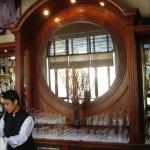The Grand Old Dame of Rangoon
"Excuse me sir, but this could be very dangerous." This ominous warning came from one of The Strand's floor butlers who rushed toward us as we approached the stairs down to the lobby. Apparently the knot at the waist of my newly purchased longyi was less than securely fastened.
Longyi are the traditional dress of Burma and worn by both males and females; although women and girls wear their longyi much like a sarong, the male version is a tubular affair about two metres wide. To tie it, one must grab the material at each side and quickly lash the two ends together in a twisted knot at the stomach, leaving a perfect inverted V down the front of the legs. Tying a longyi was a skill that comes with a little more practice than I had experienced.
After the impromptu lesson in longyi tying, the butler stepped back and observed with a critical eye. "That's better," he announced with a tone of relief in his voice. "Now there will be no accidents," he assured with a grin.
It is doubtful that this was the first time in the hotel's 108-year history that there has been a lesson in longyi tying. Service in this grande dame of old Rangoon has been well honed since the hotel's belle époque days.
* * *
Since "La Belle Époque" is a name applied in retrospect, it evokes a nostalgic melancholy for a bygone era that is lost and irretrievable. Undoubtedly, it was a label bestowed by an aging member of the European upper class recalling sadly the good old days now long past.
Literally "the beautiful era," this period between the last decades of the nineteenth century and the onset of the World War I was the golden age of travel and saw frequent luxury steamships passing through the newly opened Suez Canal to bring the privileged class to the exotic destinations of Southeast Asia.
The arrival of these affluent travellers triggered the construction of a handful of opulent Southeast Asian hotels, each it seems in a competition to be the most outstanding, the most lavish establishment east of the Suez. Those legendary grande dames of Southeast Asia-The Oriental in Bangkok (1876), The Continental in Saigon (1880), The Eastern and Oriental in Penang (1889), Raffles in Singapore (1887), The Metropole in Hanoi (1901) and The Strand in Rangoon (1901) catered to the pampered lifestyle to which the prominent and affluent were accustomed. All seemed to use some variation of "Patronized by Royalty, Nobility, and Distinguished Personages" in their advertising.
They all had their period of grandeur when they were visited frequented by the wealthy and the famous, by writers and royalty. Each eventually fell onto hard times, and each has been renovated and reborn in an attempt to recapture a bygone time.
* * *
Entering through the door of Room 207 of The Strand was tantamount to crossing a portal into a long-gone era. The teak floors creaked as we walked and we wondered if this was a planned feature of the last renovation or simply shoddy workmanship. We opted for the former, agreeing that the floors of historic hotels should creak under foot. Although the suite had all modern conveniences, they were in a setting out of colonial times. Ceilings were four metres high. Period-style lamps and sofas as well as a mahogany coffee table and dresser were arranged in the suite area of the room; the bathroom featured a deep tub with antique-looking fixtures. In addition to air conditioning, there was the requisite ceiling fan. The double bed was a two-poster with a large mahogany headboard. We learned that the suite area was originally the verandah that ran all around the hotel. Through the window, the Yangon River, which played a major role in the hotel's history, could be barely discerned through a jungle of palm trees. Through the west-facing window the only view was of a water stained, dingy, dilapidated building that may or may not have been deserted.
* * *
A name inextricably woven into half of these renowned grand old ladies is Sarkies-Martin, Arshak, Aviet, and Tigran. The hospitality empire of these four Armenian brothers has become legendary. The Sarkies Brothers, as they called their hotel enterprise, became synonymous with luxurious accommodations during that golden age of travel to Southeast Asia.
Their first hotel venture was in Penang, and began in 1884 when they purchased and revamped the Eastern Hotel. Because of the popularity of the Eastern, the Sarkies acquired a second nearby hotel. After renovation, it was opened as The Oriental Hotel. In 1889, they gave up the first hotel, but amalgamated the established cachet of its name into the second one which became The Eastern and Oriental Hotel. Without doubt the most luxurious hotel in Penang, The E. & O. gained a reputation among the privileged.
Following their success in Penang, the Sarkies Brothers established a second hotel in Singapore. In 1887, they purchased what was then a ten-room boarding house, refurbished it, and opened Raffles. It too attracted much attention among the traveling elite.
Looking to expand their growing hotel empire holdings (which now included The Kartika Wijaya Hotel, in Batu, Java), Aviet and Tigran Sarkies arrived in Burma in 1892 and purchased the British Burma Hotel located on Merchant Street a block north of Strand Road in Rangoon. They renamed it Sarkies Hotel, the only time the family name was used for one of their establishments. Four years later, however, they sold the hotel, and searched for a new location.
In 1899, the two brothers formed a partnership with British entrepreneur John Darwood, who owned a twelve-room hostelry on Strand Road next to the Rangoon River. It was agreed that Darwood would design a new three-story hotel and the Sarkies Brothers would build and manage it. The Strand opened in 1901. The sixty-room extravagant hotel had electricity five years before the rest of Rangoon. Like their other lavish hotels, this one also attracted the famous and the affluent, who disembarked from their long sea journey at the jetty in front of the hotel.
These were the times of grandeur for The Strand, and indeed all La Belle Époque's Asian grande dames. Demand was so great that in 1913 the brothers constructed an annex across from The Strand on Lewis Street. (This building is now the Australian Embassy.) The Sarkies' hotel empire also expanded to India where construction began on The Majestic in Calcutta.
* * *
On our way to dinner at the hotel's signature restaurant, we recalled a statement made by Paul Theroux in Ghost Train to the Eastern Star-an entrée here costs more than what a teacher in Burma earns in a month.
The Strand Grill was a formal room with ten well-spaced tables as well as an elevated platform with one long table that would seat perhaps a dozen. The room featured four columns, elaborate crystal chandeliers were suspended from the six-meter-high ceiling, subdued lighting was enhanced with candlelight, and a classical guitarist played intently. It was an elegant, romantic room, and throughout the evening, we were the only ones there.
Since its early days, the restaurant at The Strand has been famous for one dish-lobster thermidor. For decades, this was the entrée; the lobster thermidor at The Strand was as famed as the hotel itself.
It was not on the menu. When I explained how I had been anticipating this aspect of our stay at the hotel, the waitress' disappointment was unmistakable. At The Strand, service is a matter of pride and a guest showing even a slight sense of disappointment is not satisfactory. I tried to explain that I would find something else on the menu and that everything was fine, but from her demeanour, I regretted having mentioned the lobster. "We have not had lobster on the menu for over three months," she explained. "The chef insists on only fresh lobster and it has not been available." Again, I tried to appease her, explaining that I understood and that I had found a substitute-grilled sea scallops. Her smile faded once again and there was a new round of apologies. "I'm very sorry sir, but the scallops are not available tonight."
She excused herself, saying she wanted to talk to the chef, leaving us feeling uneasy. The guitarist finished one song and started another, smiling in our direction. A minute later, the waitress returned with a suggestion. "The chef will make you prawn thermidor. Will that be acceptable?" Her relieved smile beamed.
The prawn thermidor was succulent and made a perfect substitute. Everything else during our dinner went smoothly. Service was efficient and pleasant; the food was superb, from starters to dessert. Our glasses of wine were attended to with vigilance. We were asked several times if everything was satisfactory. Our bill inclusive of taxes, a bottle of Australian cabernet sauvignon, sparkling water, and espressos, came to $160 US, the monthly salary for six of the country's teachers. Also available in tribute to the original owners was The Sarkies Set Menu, offering four courses-soup, salad, a choice from two entrées, and dessert for $50 per person.
We left with a feeling of regret. There is a sense of sadness at being the only guests at a fine restaurant and this sentiment seemed to extend to the wait staff, each of whom seemed apologetic for the emptiness of the room. Even the guitar player, Mr. Soe Hnin Aung, seemed affected. When we told him we had enjoyed his music and wished him a good evening, his parting smile and bow communicated a trace of melancholy. We wondered if he would continue playing to the empty room.
(We learned after we left Burma that almost all of the country's lobsters were exported under the label "product of Thailand" to circumvent the boycott imposed by the West.)
* * *
When World War I erupted in 1914, the romantic golden days of travel abruptly ended as did the era that would soon be called La Belle Époque. Asia's finest hotels were deserted. The Sarkies Brothers halted construction on The Majestic and abandoned their plans for India forever.
Although the end of the war brought renewed travel to Southeast Asia and The Strand was again busy, a rift grew within the Sarkies family. In 1925, the hotel was sold to Peter Bugalar Aratoon and Ae Amovsie, also Armenians. A major renovation, which included a swimming pool, commenced with the change of ownership, and the hotel flourished. Its popularity necessitated yet another renovation in 1937 which saw an addition to the back of the building, the closing of the short-lived pool, and an increase in the number of rooms to one hundred.
But good times do not last forever. World War II was the beginning of a long decline for the grand old lady on Strand Road. Japan invaded the country and Burma became one of the fiercest theatres of the war. The four-year Japanese occupation of the country included The Strand, which was renamed the Yamato Hotel.
When Japan was defeated and back under British control, The Strand was in need of extensive repairs. But in spite of the effect of two wars, The Strand rebounded. Burma won its independence from Britain in 1948 and the future looked bright for both the country and the hotel. Air travel replaced long steamship journeys and by 1955, Rangoon had a brand new airport and was on a regular flight route. The Strand was the only luxury hotel in the country.
* * *
One evening we visited the bar which was empty when we arrived, and remained so while we were there. Like all Burmese we met, the bartender was amiable and talkative. He told us that when the Japanese occupied the hotel, they converted the bar into stables for their horses. He was inquisitive about our country and asked several questions about Canadian life; he seemed especially interested in snow, and was surprised to learn that we did not have year-round winter. He was also astounded to learn that only a small portion of the country is French speaking. At our explanation, he did not seem at all convinced. "Are you sure?" he queried. When we asked him if the bar was always empty, he nodded. "The occupancy of the hotel is normally only 10 percent," he explained. We realized that we had not seen any other guests since our arrival. "We have many tour groups who visit and have tea, but they do not stay," he lamented. We wondered if the published rates for the various types of suites might be a factor. (There are thirty-two suites at The Strand: Superior Suites go for $550 US a night, Deluxe Suites are $630 US a night, and the hotel's one special suite, The Strand Suite, costs $1100 US per night. Prices are also subject to a 10 percent service charge and another 10 percent government charge. Still, it seems that some people are willing to pay handsomely for the opportunity to rub shoulders with the ghosts of Maugham and Kipling. But in a country where the average yearly income is $300 US, somehow the price of staying at The Strand seems obscene.)
* * *
Burma's internal struggles proved to be a much greater obstacle for the hotel than two world wars. Both the hotel and the country began a long decline under the military regime that seized power in 1962. The Strand was nationalized and renamed The People's Hotel. It quickly deteriorated and by the 70s, a run-down room cost less than a martini does in today's hotel. The once-grand building continued to languish for almost three decades.
Not until 1990 did the regime show some interest in the historic old lady; a joint enterprise between the government and foreign investors closed the hotel for an extensive renovation. After three years, the hotel was reopened and it was time for its attempted renaissance. It is now operated by General Hotel Management which manages high end properties in Asia, the United States, Mexico, and the Middle East.
* * *
Time will determine whether the grande dame of old Rangoon becomes an anachronism in new Yangon. While the country has much to offer visitors, as long as it remains under the rule the paranoid junta it will not draw tourists. All news coming out of the country is negative. It is a country where freedom of speech is brutally suppressed, with protestors either shot or imprisoned. It is a country where basic human rights are constantly violated, where extrajudicial arrests, imprisonment, and torture are routine, and where forced labour is commonplace. These factors are hardly conducive to tourism.
Looking good for an old dame-well made up and still classy-she sits on Strand Road, with a wistful tinge of sadness, a pining for a period that has long gone. She waits, sustained by memories of her belle époque, smiling often at fond reminiscences and shedding a nostalgic tear from time to time at the realization that the golden era is gone forever.
* * *
Fact File:
The Strand
92 Strand Road, Yangon
Myanmar
Tel: +95 1 243377
Fax: +95 1 243393
Web: http://www.ghmhotels.com/
email: gm@thestrand.com.mm
Bangkok Airways has Bangkok to Yangon and Yangon to Bangkok flights on Sundays, Mondays, Wednesdays, Fridays, and Saturdays. Flight time: 1hour and fifteen minutes. (In most airports, but not that of Yangon, Bangkok Air's courtesy lounges provide free internet service as well as complimentary coffee, snacks, and juice.)
A Note Regarding Credit Cards. The Strand accepts MasterCard and Visa, but the transaction requires a foreign third party handler. Each transaction involves two exchange transactions-for example, US dollars are converted to another currency and then back to US dollars. An administration fee of 5 percent is added at The Strand in order to recover part of the transaction cost. The Strand is one of the few hotels accepting credit cards, and others charge up to 10 percent extra to do the transaction. Burma is a cash country and the preferred cash is American dollars. Other currencies may not be accepted.
* * * * *
 ThingsAsian
ThingsAsian




















